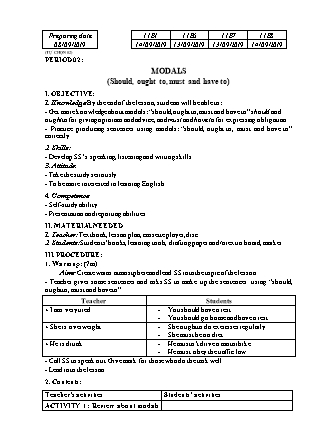Giáo án tự chọn Tiếng Anh Lớp 11 (Thí điểm) - Tiết 2: Modals - Năm học 2019-2020

I. OBJECTIVE:
1. Knowledge: By the end of the lesson, students will be able to:
- Get more knowledge about modals: “should, ought to, must and have to” should and ought to for giving opinions and advice, and must and have to for expressing obligation.
- Practice producing sentences using modals: “should, ought to, must and have to” correctly.
2. Skills:
- Develop SS’ s speaking, listening and writing skills.
3. Attitude:
- Take the study seriously
- To be more interested in learning English.
4. Competence:
- Self-study ability
- Presentation and reporting abilities.
II. MATERIAL NEEDED
1. Teacher: Textbook, lesson plan, cassette player, disc.
2. Students: Students’ books, learning tools, drafting paper and/or extra board, marker
Preparing date 11B1 11B6 11B7 11B8 08/09/2019 14/09/2019 13/09/2019 13/09/2019 14/09/2019 (TỰ CHỌN 02) PERIOD 02: MODALS (Should, ought to, must and have to) I. OBJECTIVE: 1. Knowledge: By the end of the lesson, students will be able to: - Get more knowledge about modals: “should, ought to, must and have to” should and ought to for giving opinions and advice, and must and have to for expressing obligation. - Practice producing sentences using modals: “should, ought to, must and have to” correctly. 2. Skills: - Develop SS’ s speaking, listening and writing skills. 3. Attitude: - Take the study seriously - To be more interested in learning English. 4. Competence: - Self-study ability - Presentation and reporting abilities. II. MATERIAL NEEDED 1. Teacher: Textbook, lesson plan, cassette player, disc. 2. Students: Students’ books, learning tools, drafting paper and/or extra board, marker III. PROCEDURE: 1. Warmup: (7m) Aims:Create warm atmostphere and lead SS into the topic of the lesson. - Teacher gives some sentences and asks SS to make up the sentences using “should, ought to, must and have to” . Teacher Students + I am very tired You should have a rest. You should go home and have a rest. + She is overweight She ought to do exercises regularly. She must be on diet. + He is drunk He mustn’t drive a motorbike. He must obey the traffic law. - Call SS to speak out. Give mark for those who do the task well. - Lead into the lesson 2. Contents: Teacher’s activities Students’ activities ACTIVITY 1: Review about modals (10m) Aim: Sts know more about the way to use should, ought to, must and have to Method: Ask and answer - Call on some SS to remind the differences between should, ought to, must and have to (they have learnt on Getting started – Unit 1) * should and ought to for giving opinions and advice * must and have to for expressing obligation. - Ask other to give comments. - Feedback - Remember the differences between “should, ought to, must and have to” - Give comments. - Check and take notes. Suggested answer: + We use should and shouldn’t to give our opinion or advice. + Ought to and oughtn’t to means the same as should and shouldn’t but more formal. + Must and have to are used to express obligation or the need to do something. + Must express obligation imposed by the speaker while have to express extended obligation. ACTIVITY 2:Complete the sentences by using should/ shouldn’t and ought to/ oughtn’t to(10m) Aims: Sts can practice more the way to use should and ought to Methods: Work individually and then in pairs - Ask SS to do exercise 3 – Workbook page 6. - Ask SS to find the answer individually and then exchange their answers with their partners. - Call on some SS to write their answers on board - Ask others to give comments - Feedback - Do the exercise individually and then in pairs. - Write the answers on board - Give comments. - Check and take notes. Suggested answer: 1. should 2. oughtn't 3. shouldn’t 4. ought 5. should ACTIVITY 3: Complete the sentences by using must and have to(10m) Aims: Sts practice more the way to use must and have to Methods: Work in groups - Divide class into groups of 4. - Ask SS to do exercise 4 – Workbook page 6 - Explain some new words if necessary. - Go around helping if necessary. - Call on the representative of 3 groups to write their answer on board. - Ask other to give comments. - Feedback - Do as appointed. - Write the answer on board Suggested answer: 1. don’t have to2. mustn’t 3. must/ have to 4. have to 5. has to 3. Consolidation and homework. a. Consolidation: (7m) Peter has been working for 10 hours. He _______ be very tired now. A. needn't B. must C. has to D. should It’s too late. We _______ go home now. A. should B. must C. may D. might I _______ find my own way there. You _______ wait for me. A. should / can't B. have to / must C. can / needn't D. might / mustn't I was reading the book last night before I went to bed. I never took it out of this room. It ____ be lying around here somewhere. Where ___ it be? A. might / needn't B. can / should C. shouldn't / may D. must / can When you have a small child in the house, you _______ leave small objects lying around. Such objects _______ be swallowed, causing serious injury or even death. A. should / must B. should not / might C. needn't / may D. mustn't / can't * Answers : 1.B 2. B 3. B 4.C 5.B - Teacher summaries main points of the lesson - Students listen and add some more points b. Homework: (1m) - Complete the tasks. - Prepare the next lesson at home.
Tài liệu đính kèm:
 giao_an_tieng_anh_lop_11_thi_diem_tiet_2_modals_nam_hoc_2019.docx
giao_an_tieng_anh_lop_11_thi_diem_tiet_2_modals_nam_hoc_2019.docx



